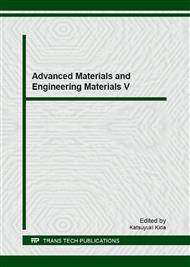p.61
p.65
p.70
p.76
p.81
p.87
p.94
p.100
p.106
Phase Field Simulation of the Lamellar Microstructure Formation in TiAl Alloys
Abstract:
The details of the lamellar microstructure in TiAl intermetallic alloys, such as the lath thickness and interfaces type governs the strength, ductility, creep properties and the long term microstructure stability of the alloy. The lamellar microstructure coarsening may induce property degradation of materials when the working temperature is high especially for the aero-engine turbine blades. At the same time, the reliability of the structure will decreases dramatically during long term working. In order to customize highly stable microstructure in high temperature, the phenomenon of lamellar formation during the solid-solid α→α2+γ phase transformation in fully lamellar TiAl alloys was investigated by phase field simulations. The lamellar structure morphology obtained with simulation is coincides with the experimental results. It is found that the independent nuclei and twin-related nuclei co-exist in the nucleation stage for the random noise nucleation. During growth stage, the independent nuclei grow slowly or disappear for the interfacial energy and elastic energy minimization. While most twin-related nuclei survived. During the following coarsening stage, big nuclei swallow small nuclei for interfacial energy minimization. The statistical character of twin area fraction changes complicated during these processes and it will be analyzed in detail. These findings could shed light on the understanding of the lamellar formation and coarsening mechanisms during phase transformation in TiAl alloys.
Info:
Periodical:
Pages:
81-86
Citation:
Online since:
August 2016
Authors:
Keywords:
Price:
Сopyright:
© 2016 Trans Tech Publications Ltd. All Rights Reserved
Share:
Citation:


